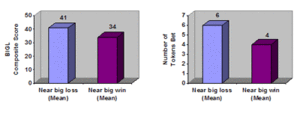Beliefs about personal luck are dynamic; these beliefs might fluctuate with the outcome of each game. A few big wins and a gambler can feel lucky; a sudden big loss and a gambler can think that luck has abandoned him. But what happens when a gambler experiences a near win (just misses a jackpot) or a near loss (just avoids losing a large sum)? The authors featured in this WAGER suggest that near losses actually increase self-perceived luck. A gambler who barely misses going bankrupt may believe it was good luck that spared him from losing. Conversely, gamblers who begin to picture a big win will perceive themselves as unlucky if this does not come to fruition. Beliefs about personal luck might influence future gambling behavior.
Wohl and Enzle (2003) investigated the relationship between personal luck and gambling behavior in two related experiments. The first experiment dealt with one type of near loss and near win condition; the second experiment built on the results of the first by introducing variations on these conditions. For simplicity and clarity, The WAGER will focus on the methodology and results from the first experiment. In the first study, the researchers recruited 30 male and female undergraduate students from an introductory psychology course at the University of Alberta. Each participant was given 5 tokens worth 20 cents each to gamble on a slot machine style wheel-offortune game. Participants were told they could keep their winnings. The wheel contained 7 sections ranging from bankruptcy to a 70 token payoff. Researchers assigned participants to one of two conditions. In the near big loss condition, the wheel slowed and came close to stopping as it passed through the bankruptcy section; however, it did not completely stop until it was just over the line into the 10 token payoff section. In the near big win condition, the wheel slowed as it passed through the 70 token section and also stopped just over the line into a 10 payoff win section. All the participants were then told they could bet part or all of their winnings on whether a roulette wheel would land on red or black, with a 1:1 payoff. Researchers recorded how many tokens the participant chose to bet. Participants then completed the Belief in Good Luck scale (BIGL, Dark & Freedman, 1997). The BIGL has 12 questions, such as “Luck works in my favor,” which the participants rated on a scale ranging from 1 (strongly disagree) to 6 (strongly agree).
As figure 1 illustrates, participants who experienced anear big loss perceived themselves as luckier than those who experienced a near big win as measured by the BIGL scale (t=2.51, p<.02). Participants experiencing a near big loss also bet a greater numberof tokens in the subsequent roulette game (5.67 compared to 3.93 in the near win condition, t=2.84, p<.01). Self-perceived luck and number of tokens bet were significantly correlated (r=.63, p<.001).
Figure 1. Differences in BIGL composite scores and the number of tokens bet after a near loss and near win
As mentioned above, the authors performed a subsequent experiment with 100 participants. This experiment utilized different types of near loss/win conditions as well as a control group that did not experience either a near loss or near win. The results of the second experiment were consistent with the results presented above; participants who experienced any type of near big loss perceived greater personal luck and bet more tokens in the succeeding roulette game. The near big win and control conditions produced indistinguishable results. These findings indicate that the differences observed in the first study were a result of a heightened perception of luck among those experiencing the near loss rather than a decrease in self-perceived luck after a near win. In the second experiment, the authors also investigated an alternative hypothesis for the difference in gambling behavior: that a change in affect rather that self-perceived luck was responsible for the increased betting. The authors asked participants to rank how they were feeling on a scale of 1 (sad) to 7 (happy) after their gambling experience.
There were no differences between groups experiencing a near loss and a near win. This further supports the role of self-perceived luck in directing future gambling behavior. The WAGER refers you to the original article (Wohl & Enzle, 2003) for more information on the second experiment.
This study contributes to our understanding of how perceptions of personal luck are shaped and how these perceptions might contribute to future gambling behavior. The study did not, however, deal with realistic conditions and this severely limits its utility. The participants were not in a “real” gambling setting; changing the setting to a real gaming establishment might influence their reactions and gambling behavior. Additionally, the participants in this study were not players with a gambling disorder. More work is needed to see if subjects with various levels of gambling disorders react similarly. If so, these findings could become central to a cognitive approach to treating pathological gambling. Understanding misconceptions about luck is the first step in helping pathological gamblers to recognize and alter their beliefs and subsequent gambling behavior.
Comments on this article can be addressed to Rachel Kidman.
References
Wohl, M. & Enzel, M. (2003) The effects of near wins and near losses on self-perceived personal luck and subsequent gambling behavior. Journal of Experimental Social Psychology, 39, 184-191.
Dark, P.R. & Freedman, J.L. (1997) The belief in good luck scale. Journal of Research in Personality, 31, 486- 511.





